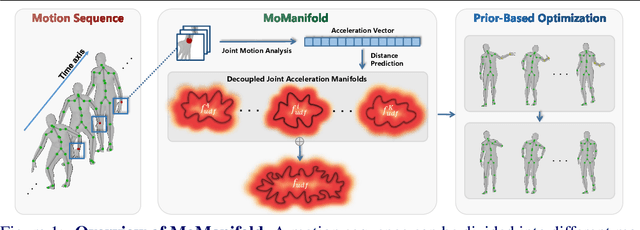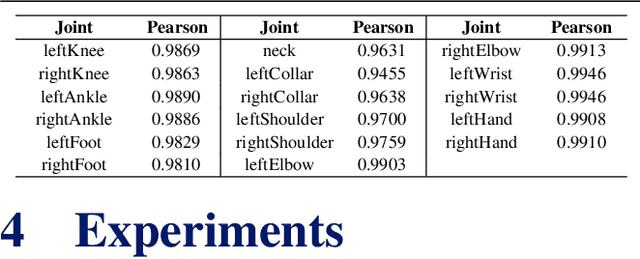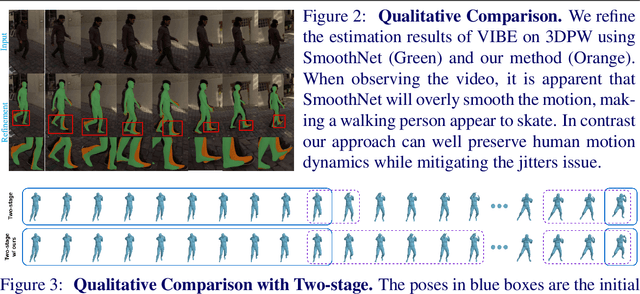Zhaopeng Cui
Free360: Layered Gaussian Splatting for Unbounded 360-Degree View Synthesis from Extremely Sparse and Unposed Views
Mar 31, 2025Abstract:Neural rendering has demonstrated remarkable success in high-quality 3D neural reconstruction and novel view synthesis with dense input views and accurate poses. However, applying it to extremely sparse, unposed views in unbounded 360{\deg} scenes remains a challenging problem. In this paper, we propose a novel neural rendering framework to accomplish the unposed and extremely sparse-view 3D reconstruction in unbounded 360{\deg} scenes. To resolve the spatial ambiguity inherent in unbounded scenes with sparse input views, we propose a layered Gaussian-based representation to effectively model the scene with distinct spatial layers. By employing a dense stereo reconstruction model to recover coarse geometry, we introduce a layer-specific bootstrap optimization to refine the noise and fill occluded regions in the reconstruction. Furthermore, we propose an iterative fusion of reconstruction and generation alongside an uncertainty-aware training approach to facilitate mutual conditioning and enhancement between these two processes. Comprehensive experiments show that our approach outperforms existing state-of-the-art methods in terms of rendering quality and surface reconstruction accuracy. Project page: https://zju3dv.github.io/free360/
NeuraLoc: Visual Localization in Neural Implicit Map with Dual Complementary Features
Mar 08, 2025Abstract:Recently, neural radiance fields (NeRF) have gained significant attention in the field of visual localization. However, existing NeRF-based approaches either lack geometric constraints or require extensive storage for feature matching, limiting their practical applications. To address these challenges, we propose an efficient and novel visual localization approach based on the neural implicit map with complementary features. Specifically, to enforce geometric constraints and reduce storage requirements, we implicitly learn a 3D keypoint descriptor field, avoiding the need to explicitly store point-wise features. To further address the semantic ambiguity of descriptors, we introduce additional semantic contextual feature fields, which enhance the quality and reliability of 2D-3D correspondences. Besides, we propose descriptor similarity distribution alignment to minimize the domain gap between 2D and 3D feature spaces during matching. Finally, we construct the matching graph using both complementary descriptors and contextual features to establish accurate 2D-3D correspondences for 6-DoF pose estimation. Compared with the recent NeRF-based approaches, our method achieves a 3$\times$ faster training speed and a 45$\times$ reduction in model storage. Extensive experiments on two widely used datasets demonstrate that our approach outperforms or is highly competitive with other state-of-the-art NeRF-based visual localization methods. Project page: \href{https://zju3dv.github.io/neuraloc}{https://zju3dv.github.io/neuraloc}
GURecon: Learning Detailed 3D Geometric Uncertainties for Neural Surface Reconstruction
Dec 19, 2024Abstract:Neural surface representation has demonstrated remarkable success in the areas of novel view synthesis and 3D reconstruction. However, assessing the geometric quality of 3D reconstructions in the absence of ground truth mesh remains a significant challenge, due to its rendering-based optimization process and entangled learning of appearance and geometry with photometric losses. In this paper, we present a novel framework, i.e, GURecon, which establishes a geometric uncertainty field for the neural surface based on geometric consistency. Different from existing methods that rely on rendering-based measurement, GURecon models a continuous 3D uncertainty field for the reconstructed surface, and is learned by an online distillation approach without introducing real geometric information for supervision. Moreover, in order to mitigate the interference of illumination on geometric consistency, a decoupled field is learned and exploited to finetune the uncertainty field. Experiments on various datasets demonstrate the superiority of GURecon in modeling 3D geometric uncertainty, as well as its plug-and-play extension to various neural surface representations and improvement on downstream tasks such as incremental reconstruction. The code and supplementary material are available on the project website: https://zju3dv.github.io/GURecon/.
CFSynthesis: Controllable and Free-view 3D Human Video Synthesis
Dec 17, 2024



Abstract:Human video synthesis aims to create lifelike characters in various environments, with wide applications in VR, storytelling, and content creation. While 2D diffusion-based methods have made significant progress, they struggle to generalize to complex 3D poses and varying scene backgrounds. To address these limitations, we introduce CFSynthesis, a novel framework for generating high-quality human videos with customizable attributes, including identity, motion, and scene configurations. Our method leverages a texture-SMPL-based representation to ensure consistent and stable character appearances across free viewpoints. Additionally, we introduce a novel foreground-background separation strategy that effectively decomposes the scene as foreground and background, enabling seamless integration of user-defined backgrounds. Experimental results on multiple datasets show that CFSynthesis not only achieves state-of-the-art performance in complex human animations but also adapts effectively to 3D motions in free-view and user-specified scenarios.
A Global Depth-Range-Free Multi-View Stereo Transformer Network with Pose Embedding
Nov 04, 2024



Abstract:In this paper, we propose a novel multi-view stereo (MVS) framework that gets rid of the depth range prior. Unlike recent prior-free MVS methods that work in a pair-wise manner, our method simultaneously considers all the source images. Specifically, we introduce a Multi-view Disparity Attention (MDA) module to aggregate long-range context information within and across multi-view images. Considering the asymmetry of the epipolar disparity flow, the key to our method lies in accurately modeling multi-view geometric constraints. We integrate pose embedding to encapsulate information such as multi-view camera poses, providing implicit geometric constraints for multi-view disparity feature fusion dominated by attention. Additionally, we construct corresponding hidden states for each source image due to significant differences in the observation quality of the same pixel in the reference frame across multiple source frames. We explicitly estimate the quality of the current pixel corresponding to sampled points on the epipolar line of the source image and dynamically update hidden states through the uncertainty estimation module. Extensive results on the DTU dataset and Tanks&Temple benchmark demonstrate the effectiveness of our method. The code is available at our project page: https://zju3dv.github.io/GD-PoseMVS/.
BlinkVision: A Benchmark for Optical Flow, Scene Flow and Point Tracking Estimation using RGB Frames and Events
Oct 27, 2024Abstract:Recent advances in event-based vision suggest that these systems complement traditional cameras by providing continuous observation without frame rate limitations and a high dynamic range, making them well-suited for correspondence tasks such as optical flow and point tracking. However, there is still a lack of comprehensive benchmarks for correspondence tasks that include both event data and images. To address this gap, we propose BlinkVision, a large-scale and diverse benchmark with multiple modalities and dense correspondence annotations. BlinkVision offers several valuable features: 1) Rich modalities: It includes both event data and RGB images. 2) Extensive annotations: It provides dense per-pixel annotations covering optical flow, scene flow, and point tracking. 3) Large vocabulary: It contains 410 everyday categories, sharing common classes with popular 2D and 3D datasets like LVIS and ShapeNet. 4) Naturalistic: It delivers photorealistic data and covers various naturalistic factors, such as camera shake and deformation. BlinkVision enables extensive benchmarks on three types of correspondence tasks (optical flow, point tracking, and scene flow estimation) for both image-based and event-based methods, offering new observations, practices, and insights for future research. The benchmark website is https://www.blinkvision.net/.
TexPro: Text-guided PBR Texturing with Procedural Material Modeling
Oct 21, 2024Abstract:In this paper, we present TexPro, a novel method for high-fidelity material generation for input 3D meshes given text prompts. Unlike existing text-conditioned texture generation methods that typically generate RGB textures with baked lighting, TexPro is able to produce diverse texture maps via procedural material modeling, which enables physical-based rendering, relighting, and additional benefits inherent to procedural materials. Specifically, we first generate multi-view reference images given the input textual prompt by employing the latest text-to-image model. We then derive texture maps through a rendering-based optimization with recent differentiable procedural materials. To this end, we design several techniques to handle the misalignment between the generated multi-view images and 3D meshes, and introduce a novel material agent that enhances material classification and matching by exploring both part-level understanding and object-aware material reasoning. Experiments demonstrate the superiority of the proposed method over existing SOTAs and its capability of relighting.
BlinkTrack: Feature Tracking over 100 FPS via Events and Images
Sep 26, 2024Abstract:Feature tracking is crucial for, structure from motion (SFM), simultaneous localization and mapping (SLAM), object tracking and various computer vision tasks. Event cameras, known for their high temporal resolution and ability to capture asynchronous changes, have gained significant attention for their potential in feature tracking, especially in challenging conditions. However, event cameras lack the fine-grained texture information that conventional cameras provide, leading to error accumulation in tracking. To address this, we propose a novel framework, BlinkTrack, which integrates event data with RGB images for high-frequency feature tracking. Our method extends the traditional Kalman filter into a learning-based framework, utilizing differentiable Kalman filters in both event and image branches. This approach improves single-modality tracking, resolves ambiguities, and supports asynchronous data fusion. We also introduce new synthetic and augmented datasets to better evaluate our model. Experimental results indicate that BlinkTrack significantly outperforms existing event-based methods, exceeding 100 FPS with preprocessed event data and 80 FPS with multi-modality data.
SplatLoc: 3D Gaussian Splatting-based Visual Localization for Augmented Reality
Sep 21, 2024



Abstract:Visual localization plays an important role in the applications of Augmented Reality (AR), which enable AR devices to obtain their 6-DoF pose in the pre-build map in order to render virtual content in real scenes. However, most existing approaches can not perform novel view rendering and require large storage capacities for maps. To overcome these limitations, we propose an efficient visual localization method capable of high-quality rendering with fewer parameters. Specifically, our approach leverages 3D Gaussian primitives as the scene representation. To ensure precise 2D-3D correspondences for pose estimation, we develop an unbiased 3D scene-specific descriptor decoder for Gaussian primitives, distilled from a constructed feature volume. Additionally, we introduce a salient 3D landmark selection algorithm that selects a suitable primitive subset based on the saliency score for localization. We further regularize key Gaussian primitives to prevent anisotropic effects, which also improves localization performance. Extensive experiments on two widely used datasets demonstrate that our method achieves superior or comparable rendering and localization performance to state-of-the-art implicit-based visual localization approaches. Project page: \href{https://zju3dv.github.io/splatloc}{https://zju3dv.github.io/splatloc}.
MoManifold: Learning to Measure 3D Human Motion via Decoupled Joint Acceleration Manifolds
Sep 01, 2024



Abstract:Incorporating temporal information effectively is important for accurate 3D human motion estimation and generation which have wide applications from human-computer interaction to AR/VR. In this paper, we present MoManifold, a novel human motion prior, which models plausible human motion in continuous high-dimensional motion space. Different from existing mathematical or VAE-based methods, our representation is designed based on the neural distance field, which makes human dynamics explicitly quantified to a score and thus can measure human motion plausibility. Specifically, we propose novel decoupled joint acceleration manifolds to model human dynamics from existing limited motion data. Moreover, we introduce a novel optimization method using the manifold distance as guidance, which facilitates a variety of motion-related tasks. Extensive experiments demonstrate that MoManifold outperforms existing SOTAs as a prior in several downstream tasks such as denoising real-world human mocap data, recovering human motion from partial 3D observations, mitigating jitters for SMPL-based pose estimators, and refining the results of motion in-betweening.
 Add to Chrome
Add to Chrome Add to Firefox
Add to Firefox Add to Edge
Add to Edge